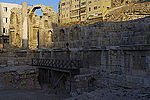Emirate of Transjordan

The Emirate of Transjordan (Arabic: إمارة شرق الأردن, romanized: Imārat Sharq al-Urdun, lit. 'the emirate east of the Jordan'), officially known as the Amirate of Trans-Jordan, was a British protectorate established on 11 April 1921, which remained as such until achieving formal independence in 1946. After the Ottoman defeat in World War I, the Transjordan region was administered within OETA East; after the British withdrawal in 1919, this region gained de facto recognition as part of the Hashemite-ruled Arab Kingdom of Syria, administering an area broadly comprising the areas of the modern countries of Syria and Jordan. Transjordan became a no man's land following the July 1920 Battle of Maysalun, during which period the British in neighbouring Mandatory Palestine chose to avoid "any definite connection between it and Palestine". Abdullah entered the region in November 1920, moving to Amman on 2 March 1921; later in the month a conference was held with the British during which it was agreed that Abdullah bin Hussein would administer the territory under the auspices of the British Mandate for Palestine with a fully autonomous governing system. The Hashemite dynasty ruled the protectorate, as well as the neighbouring Mandatory Iraq and, until 1925, the Kingdom of Hejaz to the south. On 25 May 1946, the emirate became the "Hashemite Kingdom of Transjordan", achieving full independence on 17 June 1946 when in accordance with the Treaty of London ratifications were exchanged in Amman. In 1949, after annexing the West Bank in Palestine, and "uniting" both banks of the Jordan river, it was constitutionally renamed the "Hashemite Kingdom of Jordan", commonly referred to as Jordan.
Excerpt from the Wikipedia article Emirate of Transjordan (License: CC BY-SA 3.0, Authors, Images).Emirate of Transjordan
Al-Aqsa Street,
Geographical coordinates (GPS) Address Nearby Places Show on map
Geographical coordinates (GPS)
| Latitude | Longitude |
|---|---|
| N 31.9575 ° | E 35.9475 ° |
Address
شارع الأقصى
Al-Aqsa Street
11191
Amman, Jordan
Open on Google Maps











